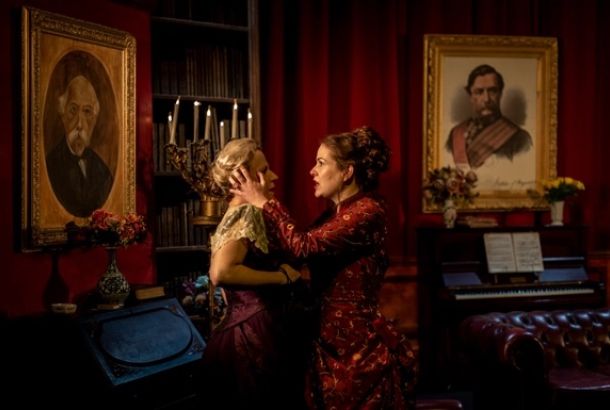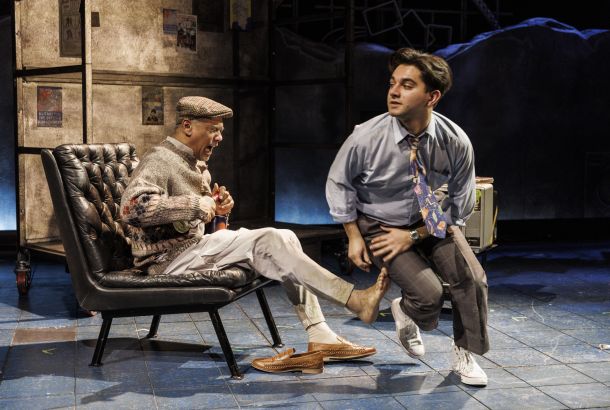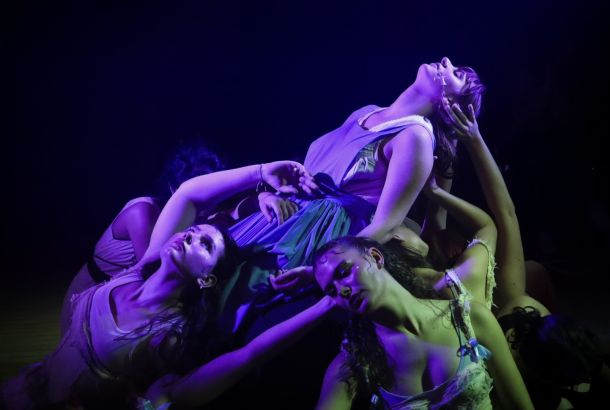
Sir Matthew Bourne OBE is a rare theatre-maker whose works I will always go to see. Even if I have little interest in the story, I’ll go to see it because I know I’ll be in awe of his creativity. I’ve previously seen The Red Shoes and Nutcracker! (the latter, his reimagining of Tchaikovsky’s third and final ballet).
I caught my third Bourne production with The Mancunion‘s Film Editor, Pip Carew, who has previously seen Bourne’s adaptation of Tchaikovsky’s first ballet: Swan Lake (which memorably featured an all-male Swan ensemble).
The third ballet in question completes Tchaikovsky’s ballet trifecta; his second ballet but the third to be adapted by Bourne: Sleeping Beauty.
Bourne (and his dance company, New Adventures) radically reimagine classic stories for contemporary audiences. He has even turned films (such as the aforementioned The Red Shoes) and operas (The Car Man is based on Bizet’s Carmen) into ballets. But reimagining a ballet is arguably more difficult, especially if you wish to win over both fans of the original and modern audiences who might not love traditional ballet (i.e. me).
The Plot
Tchaikovsky’s The Sleeping Beauty is a straightforward adaptation of Perrault’s La Belle au bois dormant. It’s rather uninteresting for a modern audience. Thus, Bourne has crafted an entirely new story. Read ahead for spoilers.
Bourne begins the tale in 1890, the year Marius Petipa choreographed the original production. The good fairies bless the infant Princess Aurora in her bedroom before the wicked fairy, Carabosse, curses her.
Flash-forward to 1911: Carabosse is dead; her son, Caradoc, vows to avenge her. Rather than fall in love with a Prince, Aurora falls for the Royal Gameskeeper, Leo. Whilst dancing with Leo, she pricks her finger on Caradoc’s rose and falls asleep for 100 years. Count Lilac, King of the Fairies, enchants the Kingdom so that everybody falls asleep until the curse is broken, before a shock reveal: he is, in fact, a (fairy) vampire. He bites Leo, turning him into an ageless, immortal fairy-vampire so that he can kiss and awake Aurora in 100 years time.
After the interval, the third act has a mini prologue, with a group of youngsters taking photographs outside the gate of the abandoned castle. It’s a clever, funny way to acknowledge the new, modern setting.
Caradoc guards Aurora, and when Leo kisses and thus awakens her, he has his guards take him away so that he can trick Aurora into thinking it was he who saved her. Aurora knows that she does not love him and tries to resist him, to no avail.
The original ballet’s wedding scene (an unnecessary final act that is essentially just a vehicle for interminable, self-indulgent dance solos) is made far more interesting, with Count Lilac and Leo eventually slaying Caradoc. Aurora and Leo marry, have a baby, and live happily ever after (as fairy-vampires).
Good vs. Bad
Updating the story is a genius idea. Opera and ballet rely on audiences already knowing the story and instead focusing their attention on the remarkable dancing. This ballet, however, puts story first, forcing audiences to pay good attention at all moments so that they do not lose sense of what is going on. You cannot allow yourself to get caught up in the dancing.
That said, the dancing in this ballet is not captivating enough for one to get caught up in. Whilst one cannot fault the skilled dancers, the choreography is far less interesting and enchanting to that you expect to see in a ballet. It’s nice, it’s sweet, it’s touching, but never quite jaw-dropping. Showoff moves take a back seat to the spectacular story, guided by Tchaikovsky’s splendid score – which Bourne juices so much drama from.
The updated setting, alone, is a wise creative decision. Having the post-slumber events take place in contemporary society enable audiences to fathom how long 100 years is and how startling it would be for one to wake up 100 years in the future.
Usually, Sleeping Beauty is set in the Middle Ages, and modern people have a tendency to see long periods of time as the same time (people are often shocked to discover that the Pyramids of Giza were older to Cleopatra than she is to us, for we see Ancient Egypt as one period in time). In reality, 100 years was always a long time – especially in the Middle Ages, where people often died before adulthood.
Of course, 20th century scientific and technological advancements make the jump from 1911 to 2011 bigger than, say, 1611 to 1711 – and the ballet acknowledges that with the de facto prologue of Act 3, in which a group of youngster take photos of the castle with their mobile phones.
The ballet’s most notable change, however, is the reimagined villain. By killing Carabosse (essentially, “Maleficent”) and introducing Caradoc, Bourne inserts a story of sexual domination and male competition. Whilst the six good fairies are evenly split between the sexes, they are ruled by a King. Aurora is caught up in a drama between three men: a wicked fairy, a fairy-vampire, and a gamekeeper-turned-fairy-vampire (but no Prince).
However, by killing Carabosse, the ballet loses its only powerful female character. Sure, Aurora is a little sassy, but she’s hardly an active heroine. The ballet seeks to be feminist, but the result is a little iffy.
A standout performance comes from Paris Fitzpatrick, who plays both Carabosse and her son, Caradoc. Carabosse is not feminine, as most female characters in ballet are, but I had no idea she was played by a man until I read the cast sheet during the interval (before spilling a drink all over myself).
Fitzpatrick has a domineering presence onstage; he’s dark, mysterious and sexy. Likewise, Dominic North is wonderful as the unsettling, liminal Count Lilac, who sits on the periphery of dark (vampire) and good (fairy). By having a wicked fairy and a good vampire, the ballet subverts preconceived notions and stereotypes associated with mythical creatures; Bourne is challenging the very notion of good vs. evil (though both Carabosse and Caradoc are solidly evil, with no redeeming features, aside for Fitzpatrick’s sexiness).
Whilst Aurora is the main character, and Ashley Shaw’s dancing and presence are lovely, she’s just not that interesting a character. She’s saccharine and possesses a little sass, but she’s a textbook fairy tale Princess, devoid of difference. Bourne’s ballet seems to use her as a vehicle to create tension and drama between the men.
However, Andrew Monaghan cannot possibly compete with the complex and compelling fairies. Leo is an amiable cypher, and whilst Monaghan does a great job of embodying a likeable, Prince-like commoner, and the audience is willing to root for him, the story and choreography do not offer him much to play with. Our attention is drawn to Caradoc and Count Lilac (who, might I add, confusingly, look like the same person).
As is always the case with New Adventures’ productions, the design is next-to-none. The stage is lined with golden pillars, Russian Imperial in architecture, a nod to Tchaikovsky’s home country. When the story finds itself in the 21st century – 2011 and “yesterday” – the costumes become contemporary but classic, like a fusion between old-and-new, signifying the 100-year slumber and the immortality of vampires, as well as tradition and honour: Carabosse died long ago but Caradoc still vows to avenge her.
The metamorphosis of Aurora’s bedroom is but one example of the carefully considered design in the ballet. The baby sleeps in a bedroom with a balcony, allowing the wicked fairy and her minions to arrive and enter with ease. When we next see Aurora, she is an adult, and she now sleeps in a bedroom with a window – presumably, in hope of restricting access for the wicked fairy. But when the gameskeeper easily climbs through her window, it is apparent: Aurora cannot escape this curse.
The baby puppet is controlled incredibly. It appears thrice: first, as Princess Aurora escaping from the staff; second, as Princess Aurora, in bed, both blessed and cursed by fairies; and lastly, as Aurora’s winged child (and yes, it flies).
The opening scene, in which Aurora repeatedly tricks her adult staff, is humorous, whilst the following scene sees the good fairies dance beautifully as they bless Aurora – though the dance sequence is never spellbinding, and thus it lasts too long. The act takes an exciting turn with the arrival of Carabosse.
Whilst the dancing is not formally impressive, Bourne masterfully employs different eras of popular dance, such as waltzes during the 1911 garden party. The ballet takes us on a journey through time, fusing and confusing different periods, signifying the challenges that would inevitably arise after a 100-year slumber – and questioning themes such as tradition and honour.
Speaking of tradition, it is something that Bourne is informed but not constrained by. He knows the rules, and he is unafraid to break them.
Matthew Bourne’s Sleeping Beauty is at The Lowry until November 26 and tours the UK until late April 2023.







